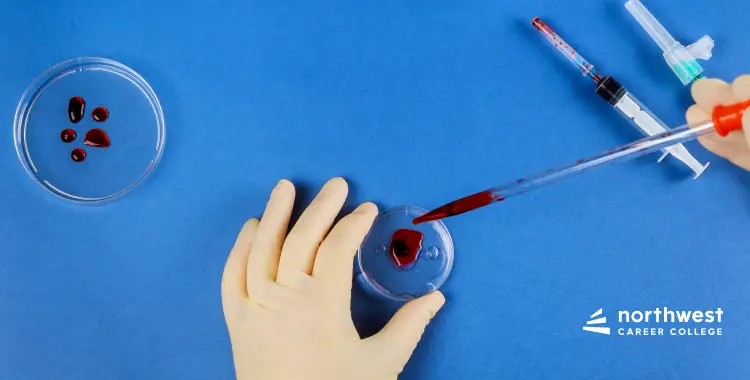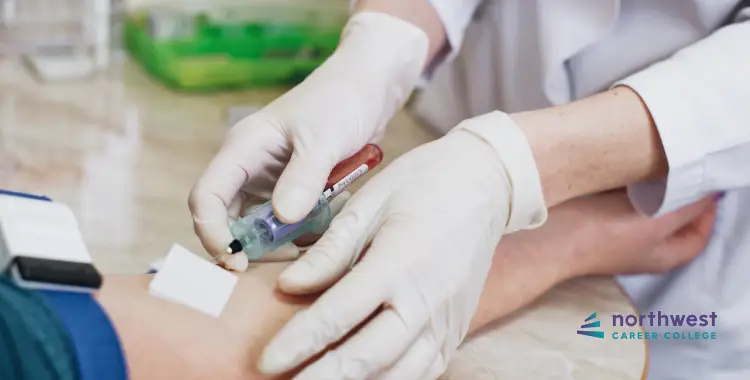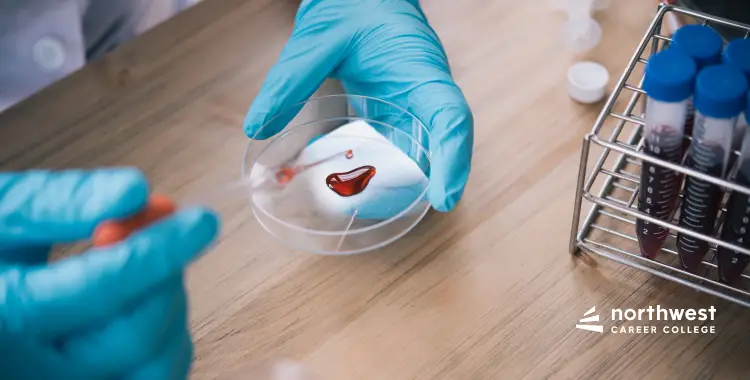Phlebotomy Guide: Red Flags in Blood Collection You Should Never Ignore
- November 21, 2025
- 10 views
- 4 min read
Watching someone draw blood might seem easy, but performing it requires skill and leaves no room for mistakes. As a professional phlebotomy technician, it is your responsibility to verify your patient’s identity to avoid any errors in the procedure. Minor problems can lead to rejected samples, resulting in wasted time for both parties.
As a future phlebotomist, you will work closely with patients daily. So, what do you do when something feels off? Trust your instincts. That internal warning system exists for good reason. Knowing what red flags to look out for will help you keep your patients safe.

Table of Contents
Recognizing Patient Distress Before Blood Collection
Continually assess your patient’s condition before beginning any procedure. You need to watch for concerning signs such as:
- Excessive sweating
- Unusual pallor
- Trembling
There are cases when patients experience lightheadedness when they see a needle. Others are terrified and are unable to speak out well.
Observe the patient’s behavior and their breathing pattern. Pause the procedure if the patient appears distressed. You can ask directly: “How are you feeling right now?” or “Are you experiencing any dizziness or nausea?”
Key Actions:
- Position the patient in a reclining chair when possible
- Keep ammonia inhalants readily available
- Never proceed if a patient appears unstable
- Allow extra time for anxious patients to compose themselves
How to Manage Poor Blood Flow During Venipuncture
Once you insert the needle, the blood should flow continuously into the collection tube. A slow flow, or if it stops unexpectedly, may be caused by improper needle positioning, tense muscles, or a damaged vein.
Do not poke the needle or shove it further. This can render the patient uncomfortable and may damage the vein, or a hematoma may occur.
Proper Response Protocol:
1. For no more than a few moments, release the pressure of the tourniquet to allow blood to re-enter the arm.
2. Tell the patient to relax the arm and open the hand.
3. If the flow doesn’t improve, pause.
4. Press the puncture site with gauze.
5. Dispose of the needle in the sharps container immediately
Remember: No more than two venipuncture attempts should be made per patient by the same phlebotomist. After two unsuccessful attempts, request help from another qualified staff member.
Identifying and Managing Hematomas
A hematoma occurs when blood leaks from a vein into surrounding tissue. It creates a visible swelling and bruising. This happens when the needle punctures through the vein wall during blood sample collection.
Immediate Response:
- Remove the needle immediately
- Apply firm, direct pressure to the site for 3-5 minutes
- Elevate the patient’s arm above heart level if possible
- Document the incident in the patient’s record
- Notify your supervisor
- Monitor the patient for 10-15 minutes before discharge
Place a pressure dressing on the wound and instruct the patient on what to do once they get home. Advise them to apply pressure to the wound in case bleeding recurs. Apply ice to the wound in 20-minute intervals every 4-6 hours during the first 24 hours. Seek medical advice if they experience increased swelling or numbness.
Preventing Label and Sample Mix-ups
Label mistakes can cause test mix-ups. That can lead to wrong results. Even the tiniest error can compromise patient care. Always double-check labels before and after the draw. Use the patient’s full name and date of birth.
Never accept “close enough” when it comes to patient identification. If there’s any discrepancy, stop and resolve it before proceeding.
Emergency Response Preparedness
Despite careful assessment, emergencies can occur during blood collection:
Fainting (Vasovagal Response):
- Lower the patient’s head below heart level
- Apply a cool, damp cloth to the forehead
- Check pulse and breathing
- Stay with the patient until they are fully recovered
Phlebotomy Technicians know how to identify potential problems before they occur. This comes from years of practice and watching for warning signs, but it starts with solid training and learning from experienced colleagues.
Each patient teaches you something new about reading the situation. Stay alert, follow your protocols, and you’ll help keep everyone safer.
Enroll Now at Northwest Career College as a Phlebotomy Technician
Northwest Career College in Las Vegas offers the hands-on experience and expert instruction necessary to tackle real-world phlebotomy challenges with confidence. Our experienced instructors combine technical expertise with practical wisdom gained from years in the field.
Take the first step toward your healthcare career. Enroll in Northwest Career College’s Phlebotomy Technician program and develop the skills that make the difference between adequate and exceptional patient care.





